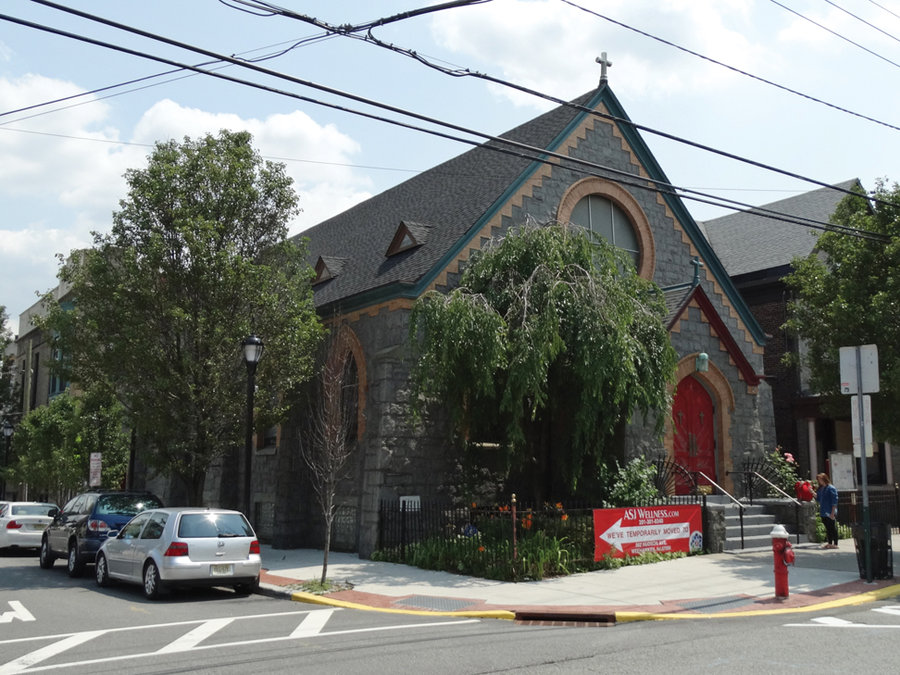St. John’s Church is changing – again. After services ended several years ago at the Episcopalian church on the Union City/North Bergen border, a group of local residents and former congregants repurposed the space to hold community functions and kids’ classes. Now a large part of the church is being sold to a developer to be turned into low-income housing for a special needs population.
On Monday, July 28 the Zoning Board of Adjustment of the City of Union City held a special public meeting at which they approved the application by Garden State Episcopal Community Development Association Corporation (GSECDC) to purchase all of the church property except the rectory and sanctuary, and build 13 condominium units within the space.
The church is on the corner of 15th St. and Palisade Ave. in Union City.
Plans call for the church to be converted into 13 units of affordable housing for legally disabled residents.
____________
Development plans
GSECDC is affiliated with the Episcopal Diocese of Newark, which currently owns the church; however, they define themselves as non-sectarian in service delivery. Established in 1986, they state their purpose as “to create healthy neighborhoods through community development intiatives… to best serve the most vulnerable in our society.”
To date they have completed 240 units, consisting of 44 units of supportive housing, 124 mixed income rentals, and 72 home ownership units.
For St. John’s, the intention is to build 13 units of supportive housing, with each being either a studio or one bedroom intended for single residents only. Three of the units on the first floor will be ADA compliant. It will be a non-smoking building.
Residents must be legally disabled (physical, medical, or mental) and collecting SSI. Applicants will go through a rigorous pre-screening procedure before being assigned.
Once approved for residency, occupants will receive an individualized assessment and comprehensive development plans, with the goal of increasing independence and self-sufficiency. Residents must comply with specific rules and regulations in order to remain housed in the building. They will pay 30 percent of their SSI income as rent.
In addition to the housing units, GSECDC will build two offices, for a case manager and a property manager, who will be on the premises from 9 a.m. to 5 p.m. Monday to Friday and on-call at all other times.
GSECDC will also build two bathrooms for the church, to replace one that is currently there. The church will retain ownership of the sanctuary. Several of the apartments will be built in the basement below the sanctuary.
The rectory, located in an adjacent structure, will also be retained by the church.
Open questions
Representatives from GSECDC and the architect that designed the new proposal presented their plans to the community at a public meeting on Monday, July 21 and answered questions from residents. One week later the proposal came before the Zoning Board for approval.
A variance was needed because no new parking spots will be provided. Normally parking is required for new residential structures, but GSECDC stated that due to the disabled status of the residents and their low income status, none of the occupants will own a car.
Local residents took the opportunity to make the Zoning Board aware of their concerns. Regarding whether Union City residents would be given priority as tenants, GSECDC Director of Housing John Restrepo stated that legally the group was required to take applicants from a statewide waiting list. However, they offered to actively engage in outreach to the local community to make people aware of the program so they could apply.
While many in the community were relieved that the church is being repurposed rather than torn down to make room for a new structure, a number of questions remained. Samuel Gato, president of the Weehawken Historical Society, pointed out that the church goes back at least as far as 1846, and he raised concerns about the future of the portion not being turned into housing units.
As a co-owned structure between the diocese and GSECDD, the exterior will be restored and maintained by the developer. The interior of the sanctuary and the rectory will be the responsibility of the diocese. No representatives of the diocese attended either meeting, so questions as to its future remained unanswered.
Those questions extended to whether community programs would be allowed to continue within the sanctuary space. Programs were suspended in recent months or moved to other locations, with after school programs moving across the street to Colin Powell School in North Bergen, for example. But the diocese had not responded to queries from the community about plans going forward.
As a good faith gesture, Restrepo offered to try to broker communications between the archdiocese and the community to allow programs to continue.
The Zoning Board granted GSECDC’s application, noting the hard work and social programs put on by the community, cautioning the developer, “please don’t let these people down.”
After the meeting, local resident Joe Kolbow said, “I think it’s good because there was great community turnout, which makes our presence a little bit more well-known as an organization.” Kolbow, a former congregant at St. John’s, organized many of the programs that took place at the church after services were suspended. “I just think it was strange there was no one representing the diocese there. I was hoping that we could have a dialogue because we still don’t know what is happening.”
Historian Gato agreed. “Its scary to think what’s going to happen after this is completed. There’s been nothing discussed regarding what is the future of St. John’s. They could say, ‘okay great, we’ve built these apartments, everything’s ready to go, now we’re going to tear down the sanctuary.’”
Art Schwartz may be reached at arts@hudsonreporter.com.
